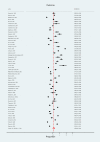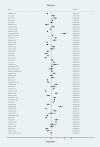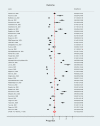Global prevalence of perinatal depression and anxiety during the COVID-19 pandemic: An umbrella review and meta-analytic synthesis
- PMID: 38113292
- PMCID: PMC10823409
- DOI: 10.1111/aogs.14740
Global prevalence of perinatal depression and anxiety during the COVID-19 pandemic: An umbrella review and meta-analytic synthesis
Abstract
Introduction: The prevalence of depression and anxiety symptoms in pregnant and postpartum women during the COVID-19 pandemic was assessed by several systematic reviews (SRs) and meta-analyses which provided contrasting and different results. We aimed to summarize the evidence relating to the global prevalence of anxiety and depression among pregnant and postpartum women during the COVID-19 pandemic.
Material and methods: An umbrella review of SRs and meta-analyses was performed. Searches were conducted in electronic databases up to April 2023. SRs and meta-analyses reporting the prevalence of perinatal anxiety and depression during the COVID-19 pandemic were selected for eligibility. Primary studies extracted from eligible meta-analyses were included in the quantitative synthesis. The research protocol was registered on PROSPERO (CRD42020173125).
Results: A total of 25 SRs (198 primary studies) and 12 meta-analyses (129 primary studies) were included in the qualitative and quantitative synthesis, respectively. Studies involved data from five continents and 45 countries. The pooled prevalence of antenatal and postpartum depression was 29% (n = 55; 95% CI: 25%-33%) and 26% (n = 54; 95% CI: 23%-30%), respectively. In the case of anxiety, the pooled antenatal and postnatal prevalence was 31% (n = 44; 95% CI: 26%-37%; n = 16; 95% CI: 24%-39%). Differences emerged between continents, with Africa having the highest prevalence of perinatal depression and Oceania and Europe having the highest prevalence of antenatal and postnatal anxiety. The prevalence also varied depending on the assessment tools, especially for antenatal anxiety. A medium-high quality of the studies was observed. One SR assessed strength-of-evidence, reporting very low strength.
Conclusions: During the COVID-19 pandemic, depression and anxiety were common, affecting almost one in three perinatal women globally. A high heterogeneity and a risk of publication bias were found, partially due to the variety of assessment tools and cut-offs. The results may not be generalized to minorities. Studies on the prevalence of clinical diagnoses are needed. Based on our results it is not possible to firmly affirm that the COVID-19 pandemic was the main factor that directly increased perinatal depression and anxiety during the past few years. Future studies should study other factors' impact.
Keywords: COVID-19 pandemic; anxiety; depression; postpartum; pregnancy; prevalence; umbrella review.
© 2023 The Authors. Acta Obstetricia et Gynecologica Scandinavica published by John Wiley & Sons Ltd on behalf of Nordic Federation of Societies of Obstetrics and Gynecology (NFOG).
Conflict of interest statement
None declared.
Figures





References
-
- Glover V. Maternal depression, anxiety and stress during pregnancy and child outcome; what needs to be done. Best Pract Res Clin Obstet Gynaecol. 2014;28:25‐35. - PubMed
-
- Stein A, Pearson RM, Goodman SH, et al. Effects of perinatal mental disorders on the fetus and child. Lancet. 2014;384(9956):1800‐1819. - PubMed
-
- Glazer KB, Howell EA. A way forward in the maternal mortality crisis: addressing maternal health disparities and mental health. Arch Womens Ment Health. 2021;24(5):823‐830. - PubMed
-
- Paschetta E, Berrisford G, Coccia F, et al. Perinatal psychiatric disorders: an overview. Am J Obstet Gynecol. 2014;210(6):501‐509. - PubMed
Publication types
MeSH terms
Grants and funding
LinkOut - more resources
Full Text Sources
Medical
Research Materials
Miscellaneous

